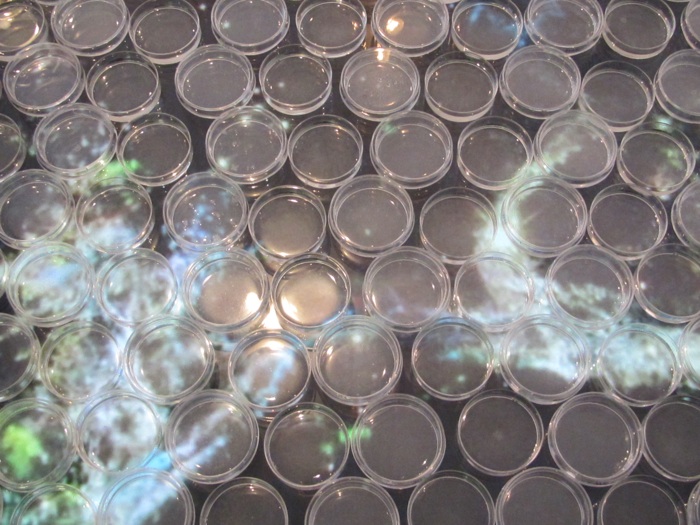“Celestial Observatories for Cyanobacteria” illuminate the knowledge gap at the San Francisco Arts Commission
“The purpose of our lives is to celebrate the grandeur of the cosmos” — William Kotzwinkle, Dr. Rat
At the age of eight, possibly inspired by my first encounter with Madeleine L’Engle’s A Wind in the Door, the notion occurred to me that just as individual cells were undetectable (to the naked eye) in the human body, so were individual human beings virtually undetectable on the great organism that is the world, and just as the planet earth was virtually undetectable in the vastness of a single galaxy, that single galaxy was virtually undetectable within the infinite scope of the universe.
As I imagined that individual cells were equally incapable of fully comprehending the individual body or organism that they inhabited, so I became aware that mere specks such as human beings could never hope to comprehend the universe entire. Not really a ground-breaking theory, you understand, but heady conjecture for an eight year-old.
It’s precisely that gap of comprehension between the very large and very small that conceptual artist Jonathon Keats addresses with his “Celestial Observatories for Cyanobacteria,” aka the Microbial Academy of Sciences.
At first glance you might mistake it for the leftovers from a classroom science experiment, a tabletop of uniform petri dishes each filled with clear liquid (“brackish water” the description clarifies). But when you bend over the otherwise unremarkable display, a projection of Hubble telescope imagery shimmers into view, a colorful array of swirling galaxies and sparkling stars, spread out across the patient petri plates, an exotic tapestry.
What you can’t really tell about the contents of the petri dishes just by looking is that each one contains cyanobacteria, oft-referred to as blue-green algae, a photosynthetic bacterium with an ability to withstand almost any environmental extreme. But whisked from the relative comfort of their “homes”, these particular bacteria are being exposed to the grandeur of the cosmos for a reason—so that they might tackle the knotty conundrum that has plagued human scientists for generations—that of a unified theory of everything. “Might it be,” wonders Keats in his artist statement, ”that organisms simpler than us are better able to grasp the simplicity underlying the universe?” If so, the cyanobacteria aren’t telling—not in a language we can comprehend anyhow. But after their higher education is over (presumably when the show closes), the plan is to introduce them back to where they originated, so that they might further educate their bacterial peers in whatever grand hypotheses they might have hit upon.
Just one exhibit of several at the San Francisco Art Commission’s “Vast and Undetectable” show, a collection of artworks exploring the stated theme in a variety of mediums, Keats’ piece comes closest to identifying the unknowable on both sides of the undetectability spectrum—from the unfathomable expanses of the cosmos, to the infinitesimal recesses of the micro-universe. And though we may never know how their exposure to astronomy will affect the microscopic “students” of Keats’ academy, we can follow their example, however briefly, by pondering the implications of a space race between beings so fundamentally disparate they might never even know that they are in competition.

